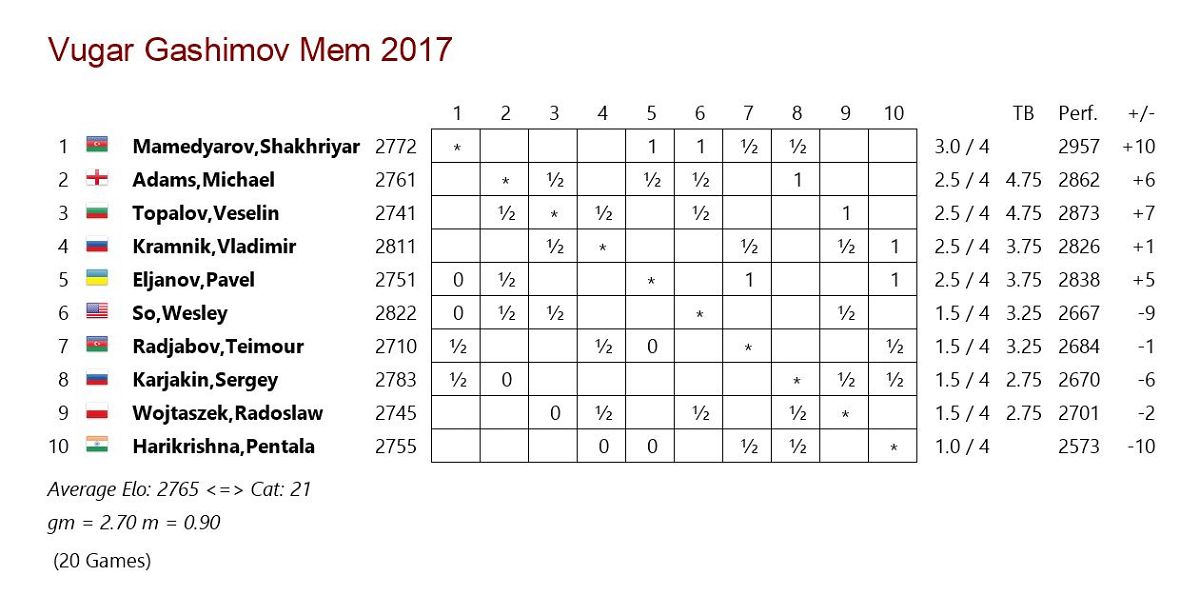Kramnik's mysterious rook sacrifice stuns Harikrishna
Kramnik's back was against the wall against Harikrishna after 24 moves in the 6.d3 Ruy Lopez. Call it desperation or a creative solution, the ex-World Champion sacrificed his rook for three pawns. Clearly the compensation didn't seem enough. However, what transpired next was a master class on how to maintain tension and slowly outplay the opponent. The computers might shout that Black was winning all along, but Harikrishna sitting opposite the Big Vlad knows that practical chess is an all together different ball game. Detailed analysis and breakdown of the game.
Harikrishna had a slow start to the Shamkir tournament with 0.5/2. He drew the first round against Karjakin and lost the second against Eljanov. In the third round he managed to draw his game against Radjabov. It was the fourth game of the tournament - Kramnik vs Harikrishna that will be the focus of the article.
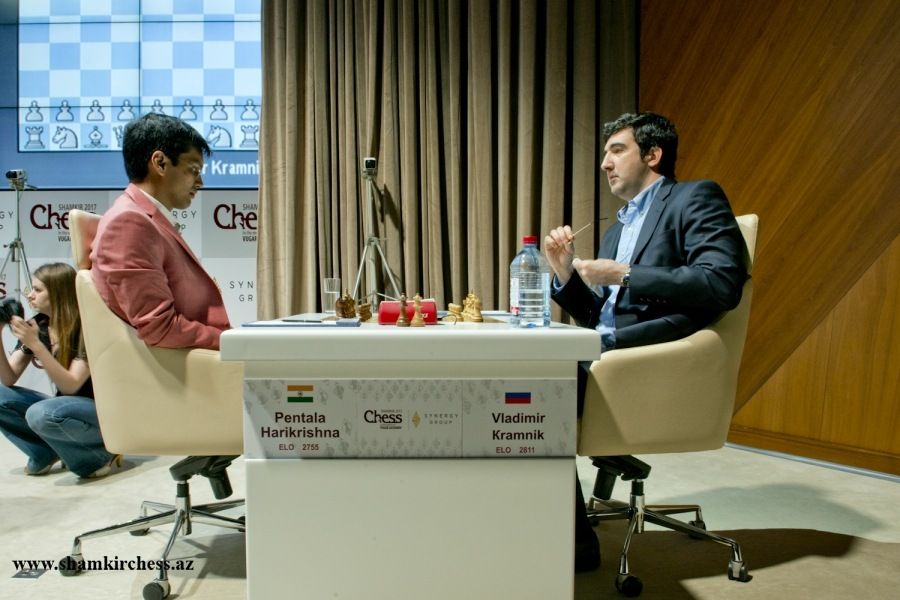
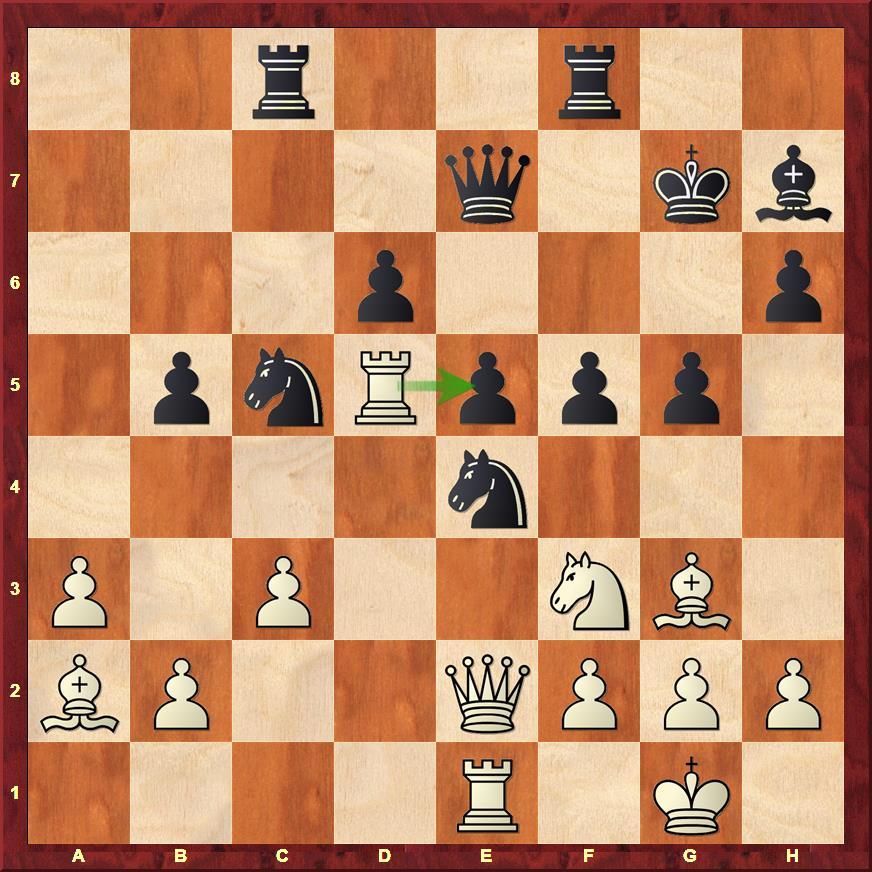
Harikrishna played the opening really well and had the things going his way. It was important for Kramnik to shift the flow of the game and hence he sacrificed an entire rook with 25.Rxe5!??

White had only three pawns for the rook, but Kramnik's confidence in his position was shown by the move 29.h3!? It says to Black, yes I am a rook down, but I don't really care. I am going to play as if the material is even!

Kramnik maintained the pressure and slowly but steadily started pushing his queenside pawns. The Black king situation never really let Harikrishna untangle fully.
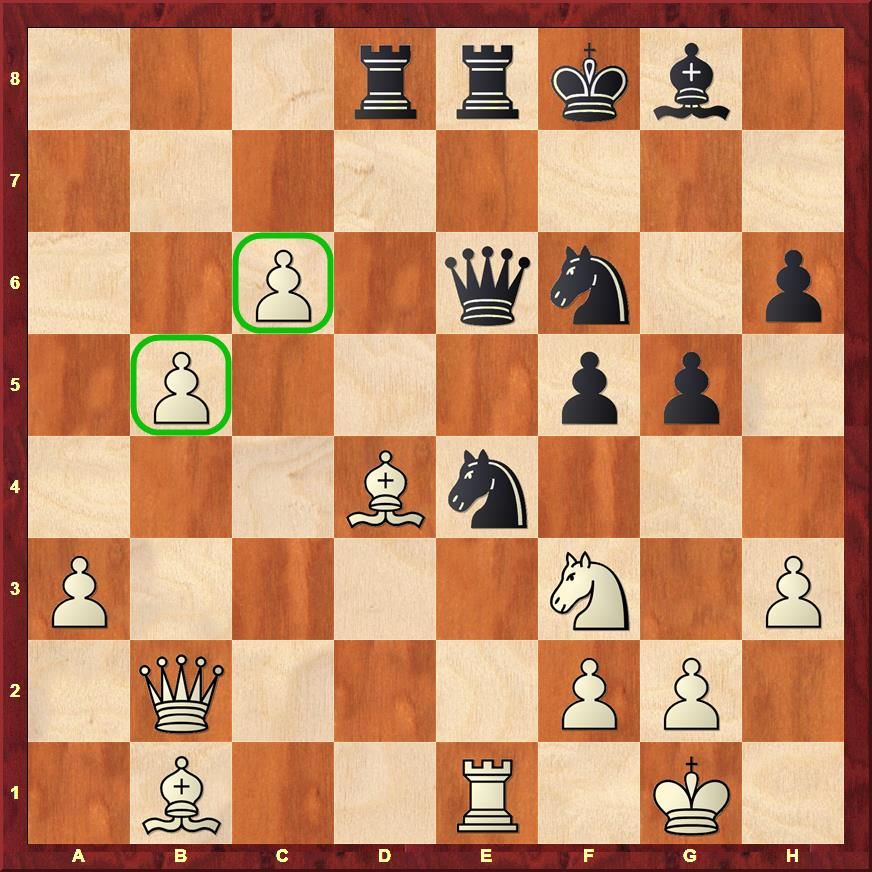
Harikrishna's indecisiveness was fatal as the pawns nearly reached the last rank and in the above position are clearly stronger than a rook!
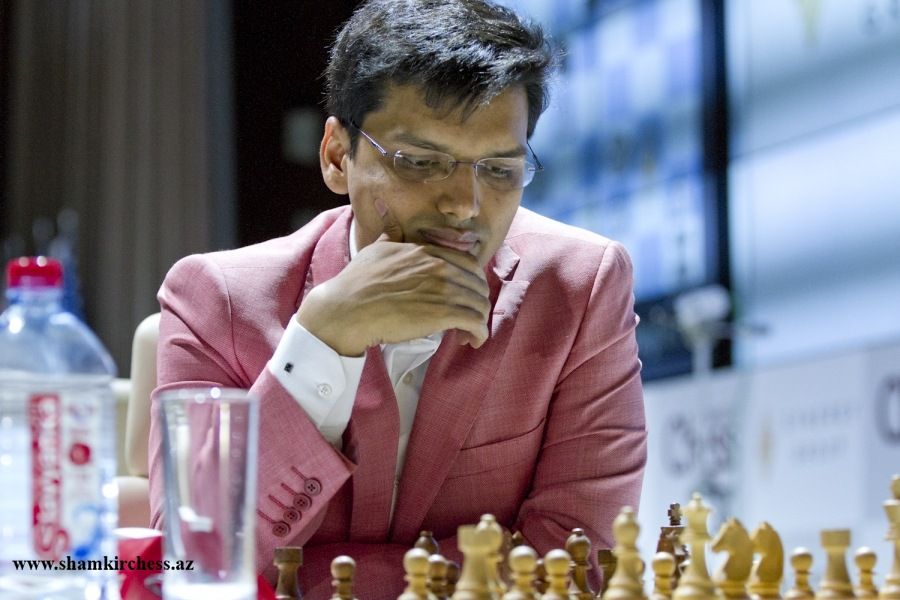
[Site "Shamkir AZE"]
[Date "2017.04.24"]
[Round "4.5"]
[White "Kramnik, Vladimir"]
[Black "Harikrishna, Pentala"]
[Result "1-0"]
[ECO "C84"]
[WhiteElo "2811"]
[BlackElo "2755"]
[Annotator "Sagar,Shah"]
[PlyCount "83"]
[EventDate "2017.04.21"]
the 6.d3 variation in the Ruy Lopez which leads to slower positions, but ones
which are less theoretical.} b5 7. Bb3 d6 8. a3 O-O 9. Nc3 Nb8 {Navara in his
annotations to the game Karjakin - Carlsen first rapid game of the World
Championship 2016 writes: The knight retreat has already been played many
times. Wesley So adopted it twice. The idea resembles the Breyer line in
Classical Ruy Lopez. In both lines Black retreats the knight to enable the
advance of his c-pawn. On the other hand, there are some differences as well.
In the Breyer, Black's knight might be better placed on d7 and its removal
from e4 increases the pressure against e4 and forces White to make some
concessions like removing his bishop from the a2-g8 diagonal by playing Bb3-c2.
Here the knight mostly comes back to c6, preventing the advance d3-d4 and
getting space in the centre. This is also often the main idea behind the
Nc6-a5 sortie in various anti-Marshall lines.} 10. Ne2 Nbd7 11. c3 Bb7 12. Ng3
c5 (12... Re8 {is the normal reaction to a knight coming to f5, so that the
bishop can tuck itself to f8. However, here Harikrishna is fine with giving up
his bishop.}) 13. Re1 Rc8 14. Nf5 c4 15. dxc4 Bxe4 (15... bxc4 16. Bc2 $14 {
is a slightly better position for White.}) 16. Nxe7+ Qxe7 17. cxb5 axb5 {
Logically Black should be fine. He has won a key central pawn and stands
pretty much fine. But White has the bishop pair and Black must remain careful
for a few moves right now.} 18. Bg5 Nc5 19. Ba2 h6 20. Bh4 g5 21. Bg3 Bh7 22.
Qe2 Kg7 (22... Bd3 23. Qe3 Bc4 24. Nd4 Bxa2 25. Rxa2 Qd7 $15) 23. Rad1 Nfe4 24.
Rd5 f5 (24... f6 {might have prevented the rook sacrifice, but it is obvious
that Hari didn't believe in the strength of the rook taking the pawn on e5.})
25. Rxe5 $5 {This move is reminiscent of Spassky's rook sacrifice against
Kholmov from 1957 where the to be World Champion sacrificed his rook for three
pawns.} (25. Nxe5 $5 Nxg3 26. hxg3 Bg8 27. Nf3 Qxe2 28. Rxe2 Rce8 $15) 25...
dxe5 26. Bxe5+ Nf6 (26... Kg6 {And the king would have been precariously
placed, but looks safe.} 27. Bd4 Bg8 $1 {Not an easy move to foress vacating
the h7 square.} 28. Ne5+ Kh7 29. Bb1 $17 {White will try to play without a
rook as if nothing happened! But it clear that objectively Black is better.})
27. Qxb5 {White has no real threats. But his two bishops are nicely placed,
and the knight comes to d4 creating a few worries. Black must remain careful.}
Nce4 $1 28. Bd4 (28. Nd4 Rfe8 29. Ne6+ Kg6 $1 30. f3 Bg8 $1 $19) 28... Rfd8 (
28... Rb8 29. Qe2 Rfe8 30. b4 Bg8 31. c4 Kh7 $17 {The game goes on but three
pawns seem like insufficient compensation for a rook.}) 29. h3 $5 {Kramnik
plays as if nothing has happened. This is already pyschology in play. Vladimir,
with all the experience that he has, must have figured that Harikrishna is
uncomfortable in the position and hence he maintains the tension and let's his
opponent decide if he wants to do anything drastic.} Rb8 30. Qe2 Bg8 31. Bb1 {
The art of maintaining the tension!} Qb7 32. b4 Re8 33. c4 {One gets the feel
that White is slowly improving his position and Black is unable to do that.
This is quite an irritating feeling.} Qc6 (33... Nd6 34. Bxf6+ Kxf6 35. Qb2+
Kg6 36. Ne5+ Kh7 37. c5 Ne4 38. f3 Qg7 39. Rxe4 $1 {Rooks aren't important.}
fxe4 40. Bxe4+ Kh8 41. Ng6+ Kh7 42. Ne7+ Kh8 43. Ng6+ $11 {would end in a draw!
}) 34. Qb2 Rbd8 35. c5 Qe6 36. b5 {The pawns keep advancing. And although they
aren't threatening any concrete just as yet, the fact that the rook was
sacrificed 11 moves ago must definitely be playing on the mind of Hari.} Kf8 $2
(36... Qb3 37. Qa1 Kg6 {Black has to play accurately to maintain the balance.}
38. b6 Bd5 39. Bxf6 Nxf6 40. Bxf5+ Kg7 41. Rxe8 Rxe8 42. Ne5 $44) 37. c6 $1 $16
g4 {Harikrishna collapses.} 38. hxg4 fxg4 (38... Bh7 39. gxf5 Bxf5 40. c7 Rd7
41. b6 $18) 39. Bxe4 gxf3 (39... Nxe4 40. Rxe4 $1 Qxe4 41. Bg7+ Kf7 42. Qf6#)
40. Bxf6 Rd6 41. Bg7+ Kf7 42. Be5 {One cannot really call Kramnik's rook
sacrifice as a bluff, because Harikrishna had all the time to find a refute
the rook sacrifice. But there was no direct refutation. The trick was that
Black had to keep making accurate moves for a long time. This is not easy for
humans to achieve. Hence, Kramnik's victory was a deserving one!} 1-0
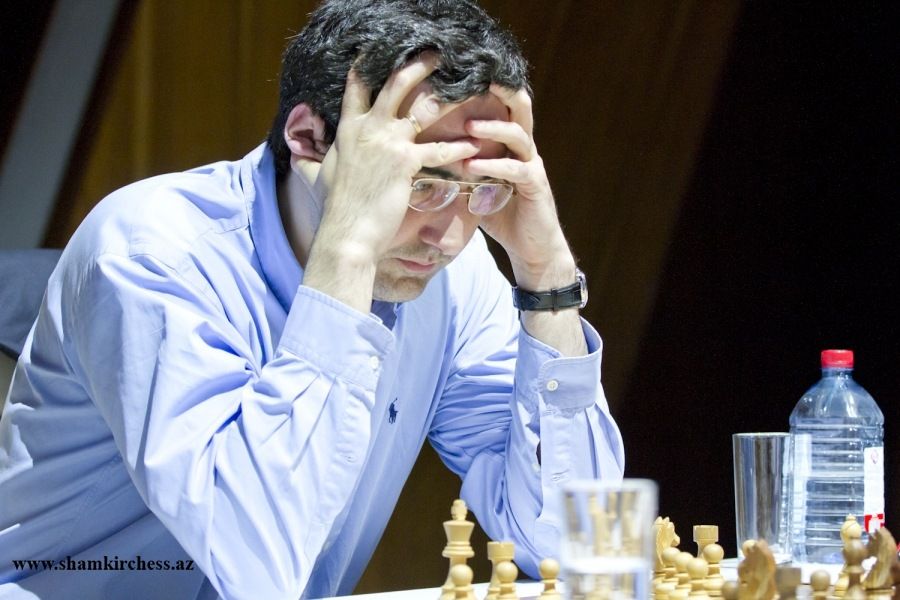
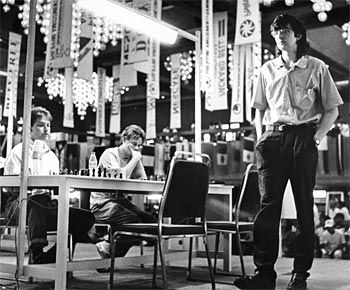

Rook sacrificed for pawns
Chess theory and history is littered with examples where a rook was sacrificed for a few pawns and an initiative. One of the most interesting positions arises from the Dragon, which was a personal favourite, at one point in my career!
[Site "?"]
[Date "2017.04.25"]
[Round "?"]
[White "Dragon variation"]
[Black "?"]
[Result "*"]
[ECO "B76"]
[Annotator "Sagar,Shah"]
[PlyCount "36"]
[SourceDate "2017.04.25"]
[SourceVersionDate "2017.04.25"]
Nc6 9. g4 Bd7 10. O-O-O Qa5 11. Kb1 Rfc8 12. h4 Ne5 13. h5 (13. Be2 $5) 13...
Rxc3 $5 14. Qxc3 (14. bxc3 Nxf3 15. Nxf3 Nxe4 {is already crushing.}) 14...
Qxc3 15. bxc3 Nxf3 16. Nxf3 Nxe4 17. Rd3 Nxc3+ 18. Kb2 Bxg4 {Black has four
pawns for the rook and clearly decent compensation. I cannot even remember the
number of games I played this on Playchess. Everytime it happened on the board
I was on cloud nine!} *

Another game which comes to mind is Spassky's famous rook sacrifice against Kholmov. This one is not as famous as Spassky's rook sacrifice against Bronstein, but still the final position is really interesting, and shows the power of pawns.
[Site "Moscow"]
[Date "1957.??.??"]
[Round "6"]
[White "Spassky, Boris Vasilievich"]
[Black "Kholmov, Ratmir D"]
[Result "1/2-1/2"]
[ECO "E31"]
[Annotator "Sagar,Shah"]
[PlyCount "82"]
[EventDate "1957.01.24"]
[EventType "tourn"]
[EventRounds "21"]
[EventCountry "URS"]
[SourceTitle "URS-ch"]
[Source "ChessBase"]
[SourceDate "1999.07.01"]
[SourceVersion "1"]
[SourceVersionDate "1999.07.01"]
[SourceQuality "1"]
d6 9. e3 Qe7 10. Nf3 Nbd7 11. Nd2 e4 12. O-O-O O-O 13. g4 g5 14. Bg3 Ne5 15. h3
Ng6 16. Be2 Re8 17. Rdg1 Bd7 18. h4 Rab8 19. hxg5 hxg5 20. Rh5 $5 {The start
of Spassky's novel concept.} Nxh5 21. gxh5 Nf8 22. Nxe4 $1 Qxe4 23. Qxe4 Rxe4
24. Bxd6 Rbe8 25. Rxg5+ Kh8 26. Bxc5 {White has won four pawns and with his
bishop pair has very good compensation for the rook.} f6 27. Rg3 b6 28. Bd4 Nh7
29. Kd2 Rg8 30. Rg6 Be8 31. Bd3 Bxg6 32. hxg6 Rxd4 33. cxd4 Nf8 34. c5 $1 bxc5
35. dxc5 Nd7 36. c6 Nb6 37. e4 Kg7 (37... Rxg6 38. d6 Rg8 39. c7 Kg7 40. Ba6
Kf7 41. d7 Nxd7 42. c8=Q Rxc8 43. Bxc8 $16) 38. Ba6 Kxg6 39. a4 Kf7 40. a5 Na8
41. Bc4 (41. d6 Rd8 $19) 41... Rd8 {And a draw was agreed. It is not so easy
to break through for Black without sacrificing material.} (41... Rd8 42. f4 Ke7
43. e5 fxe5 44. fxe5 Nc7 45. d6+ Rxd6+ 46. exd6+ Kxd6 $11) 1/2-1/2
Standings after round four
